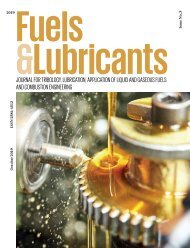Fuels & Lubricants Magazine
Issue No. 2, June 2018
Issue No. 2, June 2018
Create successful ePaper yourself
Turn your PDF publications into a flip-book with our unique Google optimized e-Paper software.
LAB CORNER<br />
A LEAN organization<br />
understands customer<br />
value and focuses<br />
its key processes to<br />
continuously increase it.<br />
Figure 1. Eight types of waste according LEAN methodology<br />
The first it is necessary to determine value of process<br />
based on customer demands. After that observation and<br />
monitoring of entire value stream and process flow is<br />
required. After determination and recording the current<br />
„As Is” state of process it is needed to establish<br />
the Future state of the process by removing the Waste<br />
or bottlenecks of the process to create flow. Establishing<br />
Pull means that the any reaction in process must be<br />
started in proper time and it must be initiated by customer<br />
and its demands. When LEAN process is created<br />
it is only remained strive to perfection. Pursuit of perfection<br />
is result from continuous application of LEAN tools<br />
and concepts. And last but not least, it is to engage and<br />
develop employees which contribute in the observed<br />
process. Change doesn’t happen simply by designing<br />
better process so it is important to involve the employees<br />
who do the work and make it clear why they should care<br />
and contribute to improvements. In Figure 2. LEAN<br />
principles are presented.<br />
The ultimate goal of<br />
LEAN methodology<br />
is to provide perfect<br />
value to the customer<br />
through a perfect value<br />
creation process that<br />
has zero waste.<br />
Figure 2. Lean principles<br />
<strong>Fuels</strong>&<strong>Lubricants</strong> No. 2 JUNE 2018 41







